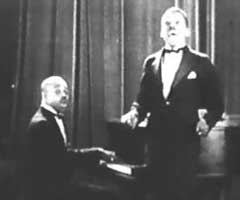 Three musical shorts which premiered in New York City at the Rivoli Theater April 15, 1923, are almost certainly the first appearance of black artists in in any sound film. Three musical shorts which premiered in New York City at the Rivoli Theater April 15, 1923, are almost certainly the first appearance of black artists in in any sound film.
These were produced as an experiment for Lee De Forest's Phonofilm sound process. Because De Forest's system recorded sound direct on film there was less of a problem with sound syncronization.
But the sound quality for the Vitaphone process, which required a recording separate from the film, had greater fidelity. The choice was then poorer sound, or poorer syncony. So it would be a few years yet before the silent era was truly threatened.
The first of these films was a three-minute short, Eubie Blake & Noble Sissle (1923) featuring the ragtime number "Affectionate Dan" which Blake & Sissle had written in 1918.
Eubie sits at the piano. Noble stands. After a momentary minor conversation, Noble sings with a very girlish voice so that lines like "You never saw such a loving man" are kinda gay. Noble's face, alas, is washed out from overlighting combined with the old age of the film.
You can barely tell that Noble is throwing his head back, opening his mouth wide, & showing his teeth; this was essential to stage presence when audiences weren't close enough to see subtler expressions, & its one reason so many of the early great performers mug exaggeratedly to the camera. Even Satchmo never got over showing enough teeth to be seen in the peanut gallery.
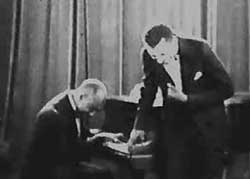 Eubie at piano is by comparison much better caught on film as he had no spotlight overlighting him, & he's much more subdued as a performer, focused in the main on his piano. Eubie at piano is by comparison much better caught on film as he had no spotlight overlighting him, & he's much more subdued as a performer, focused in the main on his piano.
However, Eubie does look up to join in on the chorus, which he did not ordinarily do, so he seems to have gotten just a little carried away by history in the making.
As "Affectionate Dan" ends, Noble bows deeply from the waist; Eubie bows from his piano bench. They then spring into a second number, Noble singing "All God's Chillun Got Shoes."
Although he tried his best to stand still to sing the first number, he just had to move on the second. But cameras were bolted in place & could not follow movement, which is why you'll see him do a "running in place" bit when on a full stage he'd've been from one end to the other.
Decades later Blake reminisced that Noble was very distraught not to be able to move about, as you'll see him doing in his usual stage manner in That's the Spirit (1933).
These two numbers are just great, & the primitive sounding recording has its own distinct charm of ages past.
It's just a wonderful performance & even the primitive sound recording gives it antique charm.
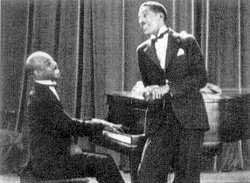 Blake & Sissle recorded their Phonofilms at deForest's sound & film studio on East 48th Street in Manhattan. Blake & Sissle recorded their Phonofilms at deForest's sound & film studio on East 48th Street in Manhattan.
Other acts recorded in the new process included vaudevillians Joe Webber & Lew Fields who ran their own music hall & brought other of their acts to De Forest's studio, including DeWolf Hopper who popularized Ernest Thayer's previously little-known poem "Casey at the Bat."
De Forest also filmed A Few Moments with Eddie Cantor (1923) & Ben Bernie & All the Lads (1924), among much else.
Very little of it was on the level of greatness as Blake & Sissle (well, Ben Bernie just might). All the Phonofilm shorts have historical signifance to the development of sound cinema, & provide fine early documents of vaudeville before the decline. But the Blake & Sissle films are even more important for the history of jazz.
Sissle & Blake: Snappy Songs (1923) divides neatly into two three minute parts. The first segment includes bits of two songs, "My Swanee Home" & "Sons of Old Black Joe." Thee two films with Noble & Sissle together are frequently run together for a single six minute film.
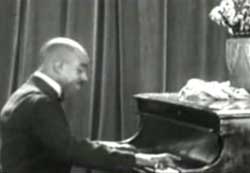 Sissle & Blake had written the first all-black-cast Broadway musical, Shuffle Along, in 1921, out of which came the eternal classic "I'm Just Wild About Harry." Sissle & Blake had written the first all-black-cast Broadway musical, Shuffle Along, in 1921, out of which came the eternal classic "I'm Just Wild About Harry."
A minor fad for white audiences attending black musicals lasted the rest of the decade. So when the three little sound films appeared, they were certainly household names in New York & London, at the least, for black & white audiences alike.
They were bringing ragtime to a new height of sophistication & simultaneously introducing the African American musical form, which was jazz, to broader audiences.
But in the last of the three early films, Eubie Blake Plays His Fantasy on Swanee River (1923) he preferred to reveal his classical training. Noble's excluded from this one; Eubie's full-throttle solo.
Seated alone at piano, head-shaven & dressed to the nines, he plays two distinct arrangements back-to-back of "Swanee River," adopting a neo-classical rather than ragtime style.
He was proud of his training & happy of this opportunity to show it, having wearied of a tendency among white audiences to believe all black entertainers were illiterate, couldn't possibly read music, would be bamboozled by Mozart, & arrived at jazz as natural jungle music without need of training.
Eubie reminisced that white audiences were so dead-set on believing this that some musicians would hide their sheet music so as not to disappoint a white audience.
It's an incredible piece of adaptation of a folksy melody to a high-brow arrangement, though the sound equipment of the time had a little trouble capturing all of it.
The film is alternately known as Eubie Blake Plays Beautified Version of 'Swanee River,' taking off from fellow piano-great Willie the Lion's name for such arrangements of folk-into-classical-into-jazz, namely "beaitification."
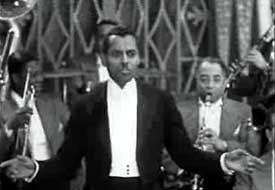 The noun "soundies" seems to originate in 1941 with the company that built & distributed Mills Panoram Jukeboxes.
The noun "soundies" seems to originate in 1941 with the company that built & distributed Mills Panoram Jukeboxes.
A soundie was, then, a three-minute music-film played on visual jukeboxes, though in reality these films were also batched together in sets of three to show as one-reel shorts in theaters, & to sell to the 8 mm & 16 mm home projector market, so "soundie" came to mean any music-oriented film short of a full-blown feature-length musical.
But in the black community "soundies" was used to mean a short film anywhere from three minutes to an hour but usually one or two reels (ten or twenty minutes) with all-black casts, & by extension any musical-short without race reference.
Whether this use of the word developed after the Panoram soundies appeared in the 1940s, or whether the Mills Panoram company latched onto pre-existent street slang, is probably unknowable. In any case the antecedants to the soundies, like the short-short Vitagraph music-films & a plethora of one-reelers, are in essence also soundies.
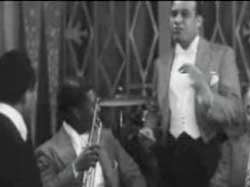 Noble Sissle & His Band from Ciro's Club & of Radio & Gramaphone Fame (1930) is a three-minute British Pathetone, precursor to the jukebox soundies of the 1940s. Pathetones of this vintage were filmed on location, so this really is at Ciro's. Noble Sissle & His Band from Ciro's Club & of Radio & Gramaphone Fame (1930) is a three-minute British Pathetone, precursor to the jukebox soundies of the 1940s. Pathetones of this vintage were filmed on location, so this really is at Ciro's.
Sissle is out in front of The Sizzling Syncopaters. He's slim & youthful, singing ragtime in his sweet high voice:
"The moon was all aglow/ And heaven was in your eyes/ The night that you told me, those little white lies/ The stars they seemed to know/ That you didn't mean all those sighs/ The night that you told me, those little white lies." I absolutely love Sissle singing this.
As Noble finishes the lyrics for "Little White Lies," the trumbone & sax trade off on soloing through the instrumental break. Then without missing a beat we're into a second song.
Drummer Jack Carter leaps up to sing a rapid rendition of "Happy Feet" at the back of the band. For close, tuba player Edward Coles rushes up front to tapdance a fine example of the aforementioned happy feet.
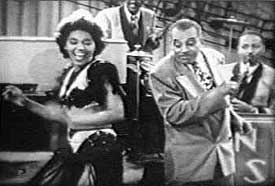 Noble Sissle again struts his stuff in front of his orchestra in Sizzle with Sissle (1946), a true jukebox soundie.
Noble Sissle again struts his stuff in front of his orchestra in Sizzle with Sissle (1946), a true jukebox soundie.
About forty-five seconds in, Mabel Lee saunters out & begins dancing in a gloriously revealing black costume designed to move & flow with her steps.
Mabel was a great beauty & first-rate jazz dancer. Director William Forest Crouch liked to believe she was his personal discovery, though she'd been a well known dancer by the time of this discovery.
Crouch starred her with Pigmeat Markham in Swanee Showboat (1940) & again with Pigmeat in the soundie Pigmeat Throws the Bull (1945), & with Louis Jordan in Reet, Petite & Gone (1947). So what small film career she had was thanks to Crouch.
Noble Sissle's music is unusually subdued rather than sizzling in Sizzle with Sissle, very likely because his intention was to frame this great dancer without himself requiring too much of the spotlight.
copyright © by Paghat the Ratgirl
|
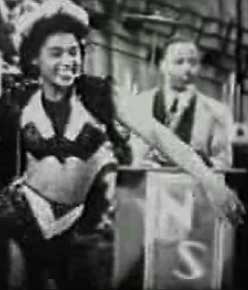

 Eubie at piano is by comparison much better caught on film as he had no spotlight overlighting him, & he's much more subdued as a performer, focused in the main on his piano.
Eubie at piano is by comparison much better caught on film as he had no spotlight overlighting him, & he's much more subdued as a performer, focused in the main on his piano.


 Noble Sissle & His Band from Ciro's Club & of Radio & Gramaphone Fame (1930) is a three-minute British Pathetone, precursor to the jukebox soundies of the 1940s. Pathetones of this vintage were filmed on location, so this really is at Ciro's.
Noble Sissle & His Band from Ciro's Club & of Radio & Gramaphone Fame (1930) is a three-minute British Pathetone, precursor to the jukebox soundies of the 1940s. Pathetones of this vintage were filmed on location, so this really is at Ciro's.